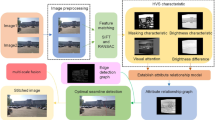Abstract
In this paper, a novel video frame rate up-conversion (FRUC) technique based on adaptive motion compensation is presented by combining the semantic feature analysis for image sequences. Firstly, the image is divided into the sub-patch with the same size and their feature areextracted. And, semantic feature analysis is adopted to generate a more accurate motion vector field from the previous frame to the following frame, and then we select these suitable classification algorithms for patial-temporal patches to divide the frame into moving areas, static areas and fault areas. By using the semantic-based adaptive interpolation, we developed a hierarchical refinement strategy to adaptively correct these motion vector so as to get the interpolation frame. Experimental results show that the performance of our method is better than those of the popular I-FRUC, B-FRUC, F-FRUC and A-FRUC methods in both objective and subjective quality, which has relative advantage for engineering applications.



Similar content being viewed by others
References
Bao W, Zhang X, Chen L et al (2018) High-order model and dynamic filtering for frame rate up-conversion. IEEE Trans Image Process 27(8):3813–3826
Dar Y, Bruckstein AM (2015) Motion-compensated coding and frame rate up-conversion: models and analysis. IEEE Trans Image Process 24(7):2051–2066
Ding X, Gaobo Y, Li R et al (2017) Identification of motion-compensated frame rate up-conversion based on residual signal. IEEE Trans Circuits Syst Video Technol
Geng B, Li YX, Tao DC, Wang M, Zha ZJ, Xu C (2012) Parallel lasso for large-scale video concept detection. IEEE Trans Multimed 14(1):55–65
Han J, Pauwels E, de Zeeuw P (2013) Visible and infrared image registration in man-made environments employing hybrid visual features. Pattern Recogn Lett 34(1):42–51
Kim Y, Park HW (2015) An efficient motion-compensated frame interpolation method using temporal information for high-resolution videos. J Disp Technol 11(7):580–588
Kim US. Sunwoo MH (2014) New frame rate up-conversion algorithms with low computational complexity. IEEE Trans Circuits Syst Video Technol 24(3):384–393
Liu B, Li Z, Yang LJ, Wang M, Tian XM (2011) Real-time video copy-location detection in large-scale repositories. IEEE Multimed 18(3):22–31
Lu G, Zhang X, Chen L et al (2017) A novel frame rate up conversion using iterative non-local means interpolation[C]//Broadband Multimedia Systems and Broadcasting (BMSB). 2017 IEEE international symposium on. IEEE, pp 1–5
Lu G, Zhang X, Chen L et al (2018) Novel integration of frame rate up conversion and HEVC coding based on rate-distortion optimization. IEEE Trans Image Process 27(2):678–691
Tang Z, Wang S, Huo J et al. (2017a) Bayesian framework with non-local and low-rank constraint for image reconstruction. J Phys Conf Ser 787(1): 012008 (IOP Publishing)
Tang Z, Wang S, Huo J et al. (2017b) Object tracking based on sparse appearance model of local structure in DCT. Video Eng
Tsai TH, Lin HY (2012) High visual quality particle based frame rate up conversion with acceleration assisted motion trajectory calibration. J Disp Technol 8(6):341–351
Wang C, Zhang L, He Y, Tan YP (2010) Frame rate up-conversion using trilateral filtering. IEEE Trans Circuits Syst Video Technol 20:886–893
Xia YJ, Chen JL, Wang CH (2015) Formalizing computational intensity of big traffic data understanding and analysis for parallel computing. Neurocomputing 169:158–168s
Xia YJ, Shi XM, Song GH, Geng QL, Liu YC (2016) Towards improving quality of video-based vehicle counting for traffic flow estimation. Signal Process 120:672–681
Xia KJ, Wang JQ, Wu Y (2017) Robust Alzheimer disease classification based on feature integration fusion model for magnetic. J Med Imaging Health Infom 7(6):1171–1176
Xia K, Jian HS, Yin, Wang JQ (2018) A novel improved deep convolutional neural network model for medical image fusion. Cluster Comput 3(2018):1–13
Author information
Authors and Affiliations
Corresponding author
Additional information
Publisher’s Note
Springer Nature remains neutral with regard to jurisdictional claims in published maps and institutional affiliations.
Rights and permissions
About this article
Cite this article
Chen, G. Frame rate up-conversion algorithm based on adaptive-agent motion compensation combined with semantic feature analysis. J Ambient Intell Human Comput 11, 511–518 (2020). https://doi.org/10.1007/s12652-018-0974-1
Received:
Accepted:
Published:
Issue Date:
DOI: https://doi.org/10.1007/s12652-018-0974-1




